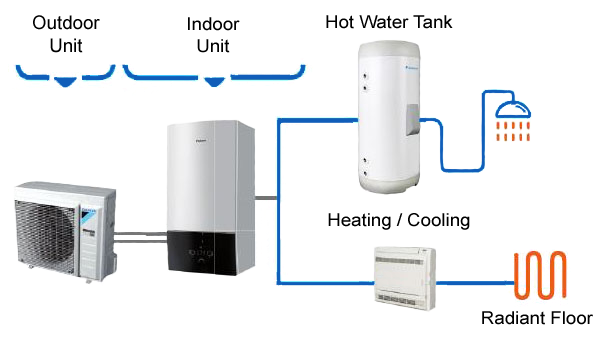Air Source Heat Pumps

Air Source Heat Pumps
Why Air Source Heat Pump
Air source heat pump technology has been in existence for several years, but only recently has it emerged as a top choice for renewable home heating.
These systems function by extracting heat from the outdoor air, which can then be utilized to warm radiators, underfloor heating, or hot water cylinders.
To illustrate the technology, one can think of refrigerators, which use air to create cold temperatures, whereas heat pumps operate in the opposite manner.
Air Source Heat Pumps
How does an Air Source Heat Pump work?
While an air source heat pump takes over from a boiler as the primary heat source at home, its operation is fundamentally distinct. Unlike a boiler, an air source heat pump does not generate heat.
Instead, it transfers heat from one location to another using the vapor compression cycle (or refrigeration process) to render it more accessible. The pump absorbs heat from the air into a fluid, compresses it, thereby increasing its temperature.
This elevated temperature is then channeled into the heating system.
Electricity is essential to operate the pump. The efficiency, indicated as the SCOP (Seasonal Coefficient of Performance), represents the heat energy output per kW of electricity. For instance, a SCOP of 3.2 indicates that 3.2kW is generated for every 1kW of electricity used.
An air source heat pump derives its energy from the surrounding air, so as the air temperature decreases, the efficiency also decreases. The greater the disparity between the outside air and the target temperature (whether it's the indoor room temperature or domestic hot water), the lower the efficiency. Therefore, understanding the heat load of the property and the performance characteristics of the heat pump is crucial.
When it comes to space heating, air source heat pumps are most effective when paired with underfloor heating, although low-flow temperature radiators can also be used.

Renewable Heat Incentives
The UK Government has established the Renewable Heat Incentive (RHI) to promote the adoption of renewable heat technologies in homes, communities, and businesses by offering financial incentives.
This pioneering scheme is the first of its kind globally and is anticipated to help achieve the government's goal of 12% of heating being sourced from renewable sources by 2020. Launched on 9th April 2014, the domestic RHI provides financial assistance for seven years to the owners of renewable heating systems.
The scheme is available in England, Wales, and Scotland, with a focus on, but not limited to, off-gas households.
